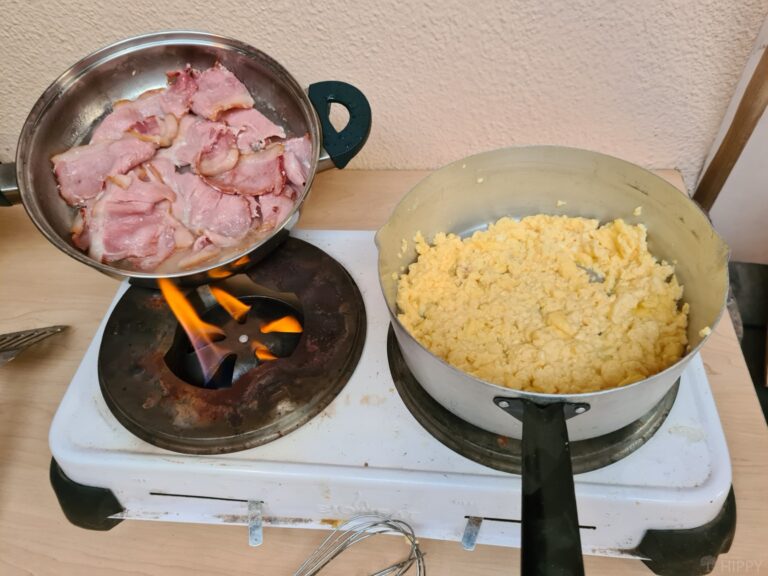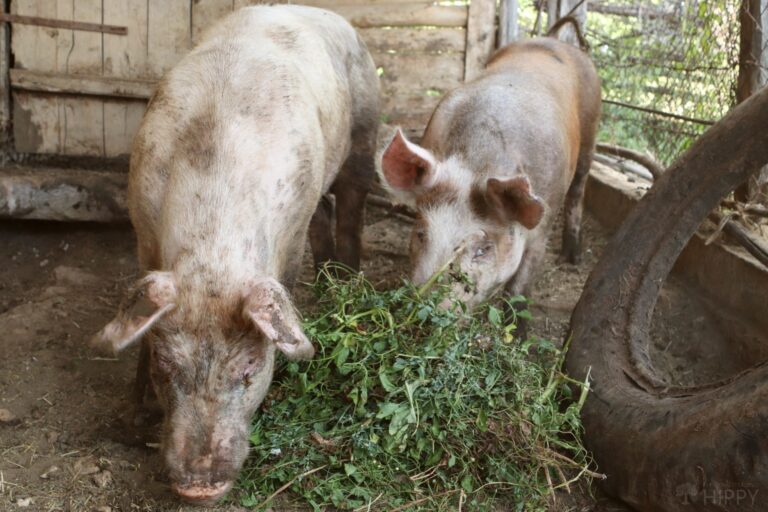Bacon is one of the most beloved foods that’s increasingly enjoyed around the world. And why not? That salty savoriness can improve any meal or almost any dish it is added to.

And of course, we all already know that bacon comes from pigs, but have you ever wondered which part of the pig, precisely, bacon comes from? Exactly which part of the pig is bacon, anyway?
Bacon is typically made from pork belly, but depending on the variety, it may come from the back, loin, jowls or other parts of the pig.
Chances are you’ve eaten bacon made from pork belly your entire life, assuming you’ve been getting your bacon from the grocery store, but there’s a whole world of bacon out there waiting for you to discover.
From international and regional variations to lesser-known but still delicious domestic preparations, I’m confident you’ll find an even greater love for bacon after reading this article. I’ll tell you more just below…
Is Bacon Pork Belly?
Yes, bacon is typically pork belly. However, not all bacon comes from pork belly!
Depending on what kind of bacon you have, and where you live in the world, bacon may not come from pork belly at all, although this is by far the single most popular cut consumed domestically here in the US.
Pork belly bacon is extremely popular, and delicious, because it comes from one of the fattiest parts of the pig, and in conjunction with the way that bacon is prepared contributes to its distinctive flavor and savoriness.
Is Pork Belly Different from Bacon?
Yes, it is. Now’s a good time to point out that bacon comes from pork belly, but bacon is also specially prepared in order to make it what it is.
Pork belly, the cut, is distinct unto itself and often sold as exactly that.
Whereas bacon is, as a rule, cured or brined, and then smoked to help preserve it and give it that incredibly delectable flavor, pork belly is not necessarily cured or smoked, and can be directly prepared and cooked as you would any other cut of pork.
For instance, pork belly is popular grilled or roasted with a variety of other seasonings or ingredients- not just cured, brined smoked- although it still might be!
So to be clear, many kinds of bacon are made from pork belly, but pork belly is not necessarily made into bacon. I hope that makes sense!

What Other Parts of a Pig Produce Bacon?
I mentioned above that much of the bacon we eat here in America, in fact the vast majority, comes from pork belly but you should know that actual, real-deal bacon can come from many other parts of the pig.
One popular variation is loin bacon or back bacon, although you likely haven’t had it under that name.
If you’ve ever had Canadian bacon, though, you had loin bacon!
This cut of bacon is much closer to the taste and texture of a typical ham slice but it is still genuinely bacon.
Another popular variety is shoulder bacon, which is also leaner but still cured and smoked the same as any other bacon slice.
I particularly like shoulder bacon because it’s so intensely flavorful, but it’s a lot more filling and leaner than traditional pork belly bacon.
Then you have special cuts taken from the flanks or jowls of the pig…
These are noteworthy because they tend to taste very similar, yet different, to typical pork belly bacon and are a great way to try something new while still keeping that familiar bacon flavor and texture we all love so much.
Also, there are many other varieties and regional or national spins on bacon, and I’ll tell you about more of them later on in this article.
How is Bacon Made?
You know the old saying that you never want to see how the sausage is made?
That might be true, but I’m happy to report that making bacon is quite a bit cleaner and simpler than that messy affair.
It’s also a very interesting process that you can do yourself if you are so inclined!
Although there are some variations in preparation, the following steps are typically used to produce bacon:
1. Cut
To make bacon, you’ve got to start with a cut of pork.
This will come from one of the parts of the pig described above, be it classic pork belly, loins, shoulder, neck, jowls, or even the back.
When the cut is chosen and prepped, it’s time to start curing the bacon.
2. Dry Cure
Dry curing is the most popular and common way of preparing bacon, and as the name suggests, consists of packing the cut of pork with salt and sugar and sometimes other seasonings.
This is directly responsible for the flavor profile of the bacon, and pretty much anything goes here, including salty and savory ingredients.
On dry curing, the cut of pork will be left to rest for days to weeks depending on the desired outcome and the thickness of the slab.
Aside from flavor, it’s this step that draws moisture out of the pork and helps to preserve it.
3. Brine
As an alternative to dry curing, brining, which is also known as wet curing, is immersing the slab of pork in liquid, usually a solution of salt and sugar along with any other flavorings as above.
Brining has an advantage in that it allows the flavors to be more evenly and quickly absorbed into the pork, and the process itself takes less time, as little as a few hours or as long as a handful of days.
4. Smoke
An optional but common step in bacon production, smoking gives bacon that indefinable delicious flavor, and also helps to further preserve the bacon.
Whatever kind of wood is used to produce the smoke, this flavor will likewise be imparted into the bacon.
The combination of curing or brining and smoking gives bacon a surprisingly long shelf life and its stability compared to other meats, and is the reason why bacon was historically considered a good food for relatively long-term storage on lengthy travels.
5. Slice and Package
With all the preparatory steps complete, the slab of bacon will be sliced and packaged, with packaging depending on who is making the bacon and whether or not they are selling it.
Bacon is invariably sliced pretty thin, even in the case of thick-cut bacon, to promote even, rapid cooking.
And that’s it. Although there are many variables in each step, and everyone has their own preferred method for producing bacon, the overall process is fairly simple and well-understood.
Bacon Cut Types
There are lots of different types of bacon out there, subtle variations on the usual pork belly bacon we all know and love, to truly different and unique kinds from other countries.
I’m here to tell you that each and every one of them has a place in your culinary arsenal, and I encourage you to try all of them.
You’re bound to find a new favorite on the list below!
1. Streaky Bacon
You’ll sometimes see the classic pork belly bacon I’ve referred to several times in this article referred to as streaky bacon.
That’s because it is thin and “streaked” with long lines of fat, giving it a distinctive striped appearance.
2. Canadian Bacon
Canadian bacon is a variety of loin bacon as I detailed above, with a taste and texture that’s much closer to a typical cut of ham.
It’s still bacon, strictly speaking, but might not squash your craving for bacon if that is really what you are after!
3. Back Bacon
You may also know back bacon by it’s other name – loin bacon.
4. Broadback/Cottage Bacon
Typically taken from butt roast or pork shoulder, this bacon tends to be reasonably fatty but still quite meaty like a typical cut of ham, though it will be cured and smoked just like pork belly bacon. Delicious, one of my favorites!
5. Short-cut Bacon
A leaner variety of back bacon that typically has a layer of fat which can be cut away prior to cooking if you want to cut down on calories.
6. Center-cut Bacon
This is pork belly bacon which is taken from closer to the bone, meaning it has less fat and more meat by weight. Typically considered a higher quality cut of pork belly bacon.
7. Pancetta
This is a fancy name for Italian pork belly bacon.
You’ve probably seen this in advertising and on commercials rolled up and tied with string which is typical of the curing process. A common ingredient in legitimate, traditional Italian cooking.
8. Lardon
Lardon is essentially cubes of bacon used for preparing stock or sauces.
9. Guanciale
This is another Italian variety of bacon. This cut is taken from the jowls and is extensively cured, producing a chewy, extremely savory, salty cut of ham-like bacon.
10. Slab Bacon
Slab Bacon is bacon that is unsliced. Also refers to the cut of pork that is used to prepare bacon as detailed above.
Tom has built and remodeled homes, generated his own electricity, grown his own food and more, all in quest of remaining as independent of society as possible. Now he shares his experiences and hard-earned lessons with readers around the country.
Find out more about the team here.
